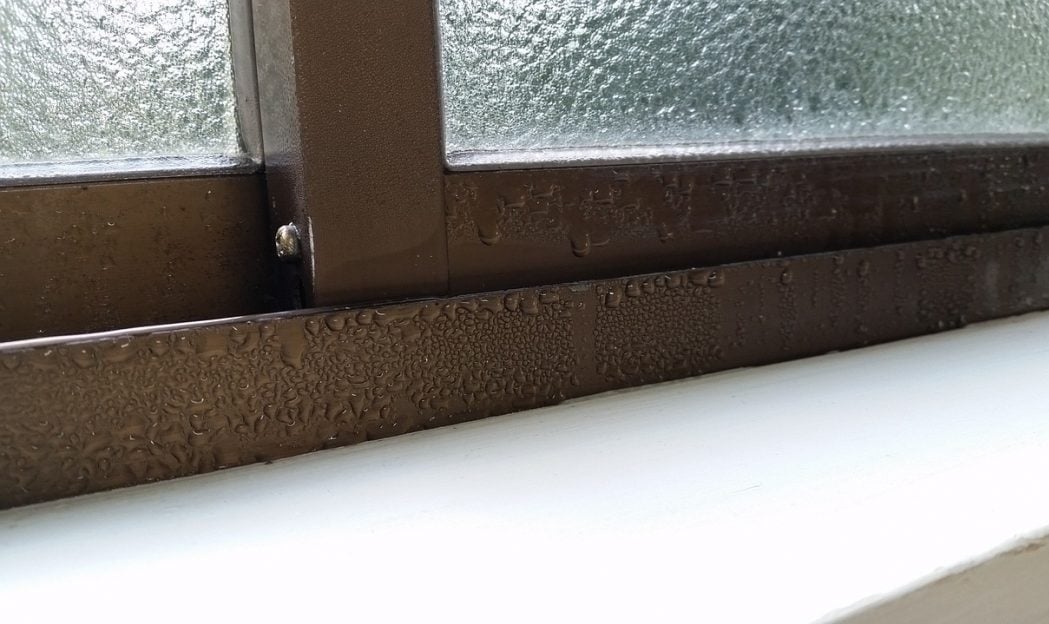Condensation on windows in cold weather isn’t just unsightly; it also often leads to annoyingly wet frames and sills. Worse, that moisture can result in the growth of potentially harmful mould.
The condensation occurs because warm moisture in the air inside your home comes in contact with cold windows. That contact turns the moisture in the air into a liquid, just the way a glass of cold lemonade beads up with condensation on a hot July afternoon.
The good news is that you can eliminate or at least reduce condensation on windows.
First things first
If you have a newly built home, it’s possible that the construction materials are still drying out, throwing off excess moisture in the process.
A very wet summer and fall may also have laden your home’s structure with moisture, which will take a while to dry.
In both cases, time may decrease your condensation problem.

This device combines a hygrometer, thermometer and clock.
Regardless, start with an inexpensive hygrometer ($25 or less at Canadian Tire and other retailers). It will measure the relative humidity level inside your home so you have a benchmark and can track the success of your remediation efforts.
The relative humidity inside your home should normally be around 50 per cent. If it’s up to 70, it’s way too high. In very cold weather, when condensation problems increase, aim for as little as 30 per cent.
How do you reduce the relative humidity?
Upgrading your windows is a good start. A triple-glazed window is warmer on the inside than a double-glazed and will therefore have less condensation.
Just remember that going with a better sealed window won’t necessarily solve your problem because it will keep more warm, moisture-filled air trapped inside the house. You need well-sealed windows with higher insulating value that actually reduces the cold on the inside glass.
However, new windows are expensive and take time to get replaced.
As a temporary window fix, a heat-shrink, insulating window kit will reduce both drafts and condensation. You’ll find the easy-to-use kits at almost any building materials or hardware store.
A word of caution about blinds and drapes. Closing them will make the interior surface of your windows colder, thereby increasing condensation when warm air finally hits the window. Better to keep window coverings open in very cold temperatures.

Indoor plants: avoid too much of a good thing.
If you have a lot of indoor plants, transpiration could be throwing too much moisture into the air. Consider farming out some of the plants to friends until warmer weather arrives.
You can also open a door or window for a short time. That will cost you a bit of warmth but will bring in some cold air to soak up that excess indoor moisture because cold air holds less moisture than warm air.
Don’t count on a dehumidifier to solve your condensation problem, says Ross Elliott, owner of Homesol Building Solutions and an expert in energy-efficient and environmentally sustainable homes. “A portable dehumidifier only gets humidity down to about 50 per cent (and) uses a lot of energy,” says Elliott.
Other fixes
If you don’t already have one, get a heat recovery ventilator (HRV) or energy recovery ventilator (ERV) installed. While they deal with humidity differently, they both exhaust stale air and replace it with warmed, fresh, outdoor air.
If an HRV or ERV is beyond your budget (they cost $2,000 or more installed), Elliott suggests “a good, silent bathroom fan like a Panasonic WhisperGreen that runs on both occupancy and (can be) set up to run 24/7 through the winter. People worried about electricity costs running a fan all winter should note a fan like that … uses about one penny’s worth of hydro per day.”
Elliott adds that, in older homes, dirt floors in basements or crawl spaces are major sources of moisture.
You can also reduce humidity by leaving the hood fan above your stove running for 10 or 15 minutes after you finish cooking to completely eliminate excess moisture.
Sources: Canadian Home Workshop, The Family Handyman, others.

